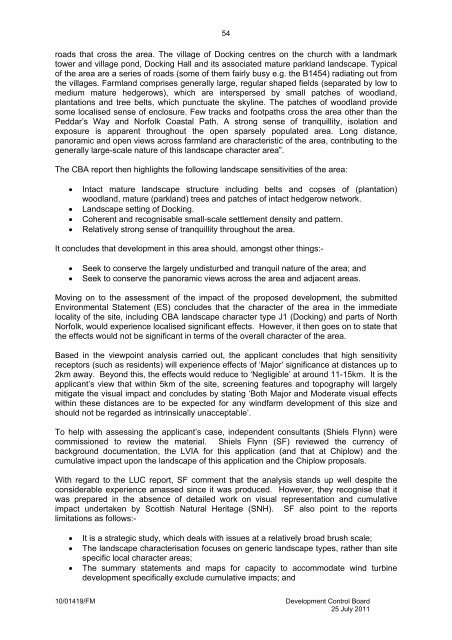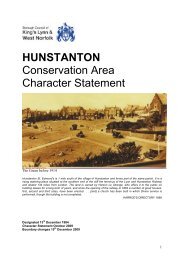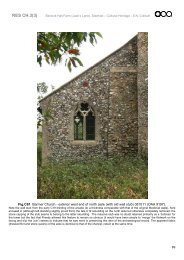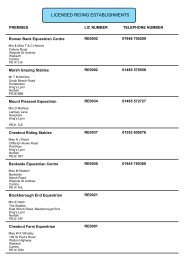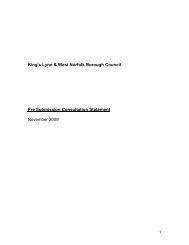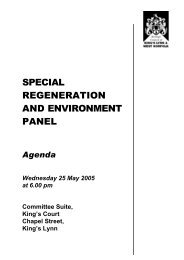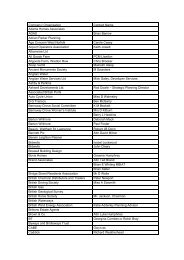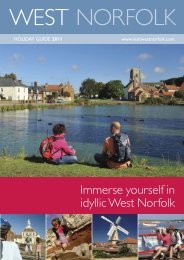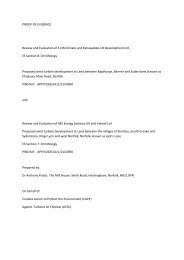11/00713/F - Borough Council of King's Lynn & West Norfolk
11/00713/F - Borough Council of King's Lynn & West Norfolk
11/00713/F - Borough Council of King's Lynn & West Norfolk
You also want an ePaper? Increase the reach of your titles
YUMPU automatically turns print PDFs into web optimized ePapers that Google loves.
oads that cross the area. The village <strong>of</strong> Docking centres on the church with a landmark<br />
tower and village pond, Docking Hall and its associated mature parkland landscape. Typical<br />
<strong>of</strong> the area are a series <strong>of</strong> roads (some <strong>of</strong> them fairly busy e.g. the B1454) radiating out from<br />
the villages. Farmland comprises generally large, regular shaped fields (separated by low to<br />
medium mature hedgerows), which are interspersed by small patches <strong>of</strong> woodland,<br />
plantations and tree belts, which punctuate the skyline. The patches <strong>of</strong> woodland provide<br />
some localised sense <strong>of</strong> enclosure. Few tracks and footpaths cross the area other than the<br />
Peddar’s Way and <strong>Norfolk</strong> Coastal Path. A strong sense <strong>of</strong> tranquillity, isolation and<br />
exposure is apparent throughout the open sparsely populated area. Long distance,<br />
panoramic and open views across farmland are characteristic <strong>of</strong> the area, contributing to the<br />
generally large-scale nature <strong>of</strong> this landscape character area”.<br />
The CBA report then highlights the following landscape sensitivities <strong>of</strong> the area:<br />
� Intact mature landscape structure including belts and copses <strong>of</strong> (plantation)<br />
woodland, mature (parkland) trees and patches <strong>of</strong> intact hedgerow network.<br />
� Landscape setting <strong>of</strong> Docking.<br />
� Coherent and recognisable small-scale settlement density and pattern.<br />
� Relatively strong sense <strong>of</strong> tranquillity throughout the area.<br />
It concludes that development in this area should, amongst other things:-<br />
� Seek to conserve the largely undisturbed and tranquil nature <strong>of</strong> the area; and<br />
� Seek to conserve the panoramic views across the area and adjacent areas.<br />
Moving on to the assessment <strong>of</strong> the impact <strong>of</strong> the proposed development, the submitted<br />
Environmental Statement (ES) concludes that the character <strong>of</strong> the area in the immediate<br />
locality <strong>of</strong> the site, including CBA landscape character type J1 (Docking) and parts <strong>of</strong> North<br />
<strong>Norfolk</strong>, would experience localised significant effects. However, it then goes on to state that<br />
the effects would not be significant in terms <strong>of</strong> the overall character <strong>of</strong> the area.<br />
Based in the viewpoint analysis carried out, the applicant concludes that high sensitivity<br />
receptors (such as residents) will experience effects <strong>of</strong> ‘Major’ significance at distances up to<br />
2km away. Beyond this, the effects would reduce to ‘Negligible’ at around <strong>11</strong>-15km. It is the<br />
applicant’s view that within 5km <strong>of</strong> the site, screening features and topography will largely<br />
mitigate the visual impact and concludes by stating ‘Both Major and Moderate visual effects<br />
within these distances are to be expected for any windfarm development <strong>of</strong> this size and<br />
should not be regarded as intrinsically unacceptable’.<br />
To help with assessing the applicant’s case, independent consultants (Shiels Flynn) were<br />
commissioned to review the material. Shiels Flynn (SF) reviewed the currency <strong>of</strong><br />
background documentation, the LVIA for this application (and that at Chiplow) and the<br />
cumulative impact upon the landscape <strong>of</strong> this application and the Chiplow proposals.<br />
With regard to the LUC report, SF comment that the analysis stands up well despite the<br />
considerable experience amassed since it was produced. However, they recognise that it<br />
was prepared in the absence <strong>of</strong> detailed work on visual representation and cumulative<br />
impact undertaken by Scottish Natural Heritage (SNH). SF also point to the reports<br />
limitations as follows:-<br />
� It is a strategic study, which deals with issues at a relatively broad brush scale;<br />
� The landscape characterisation focuses on generic landscape types, rather than site<br />
specific local character areas;<br />
� The summary statements and maps for capacity to accommodate wind turbine<br />
development specifically exclude cumulative impacts; and<br />
10/01419/FM Development Control Board<br />
25 July 20<strong>11</strong><br />
54


